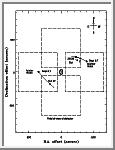|
COMETS EARTH JUPITER KUIPER BELT MARS MERCURY METEORITES NEPTUNE OORT CLOUD PLUTO SATURN SOLAR SYSTEM SPACE SUN URANUS VENUS ORDER PRINTS
PHOTO CATEGORIES SCIENCEVIEWS AMERICAN INDIAN AMPHIBIANS BIRDS BUGS FINE ART FOSSILS THE ISLANDS HISTORICAL PHOTOS MAMMALS OTHER PARKS PLANTS RELIGIOUS REPTILES SCIENCEVIEWS PRINTS
|
Related Document
Download Options
This diagram shows the position of the moons relative to Uranus. Uranus is shown at the center of the plot (not to scale). The circular orbits of the outermost two previously known moons (Titania and Oberon) surround the planet, and appear as ellipses because the orbits viewed from Earth are somewhat edge on. The four search fields for the discovery observations of September 6 and 7 surround the planet, each box (dashed) showing one field that the digital detector saw during a single exposure. The fainter moon was discovered almost directly east of the planet (note that east is to the left when looking up at the sky while facing south). The brighter moon was west and somewhat north at the time of discovery. The arcs that the satellites followed after discovery are shown, corresponding to the preliminary fits to the orbits of the moons, calculated by Brian Marsden of the Minor Planet Center at Harvard University. The observations from the Palomar 5-meter telescope are shown as large dots. The small squares on October 9 and 18 are two of several observations beginning on the former date by the amateur astronomer Warren Offut. The predicted paths are shown out until November 15th, 1997. Observations after this date will be difficult due to the fact that the Earth is moving to the opposite side of the Sun than Uranus, and so the planet will become unobservable until the spring of 1998. |
